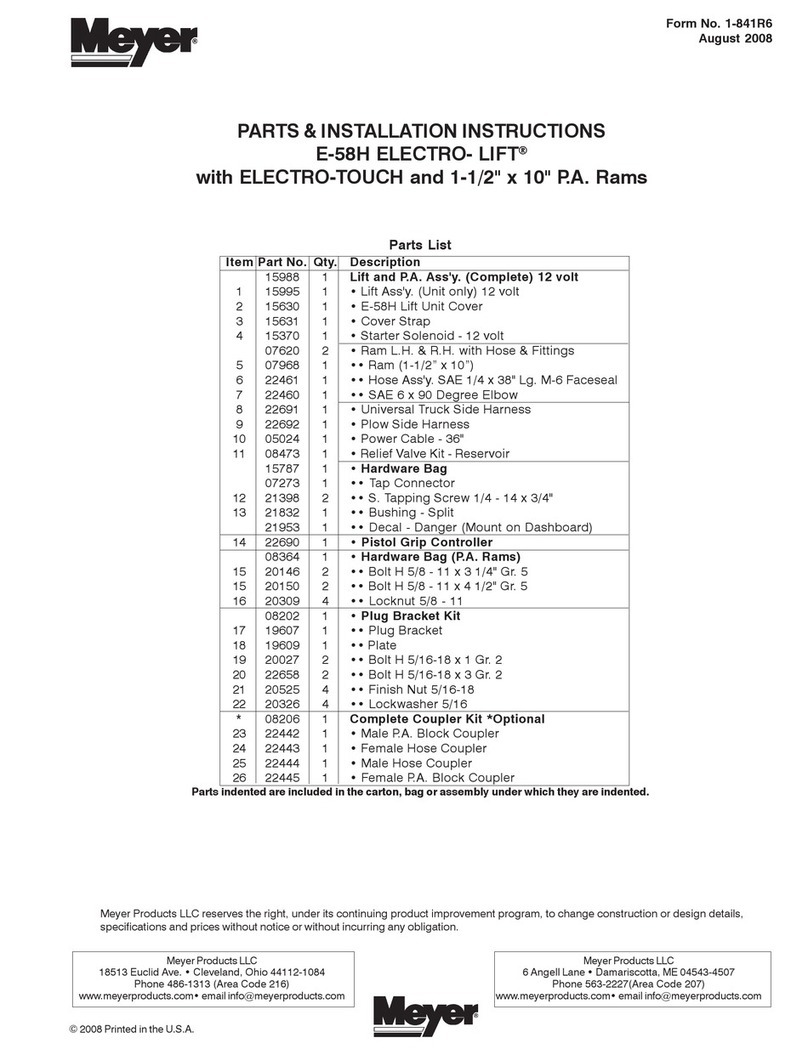
Meyer Hydraulics Corp.
ETJ 2000 Series Operating & Servicing Instructions
4. For coarse adjustment of the ETJ height, step hard on the right (intake) side of the Foot Valve
Control (61) for lifting, or on the left (exhaust) side for lowering. This activates both the Air Valve
(47) and one of the Hydraulic Valves (71 or 72) at the same time. Within 0-3 seconds the Pistons
(3)(12) will begin their travel smoothly, but briskly. All movement will immediately stop the instant
the pressure is taken off the Foot Valve Control.
5. For fine adjustment of the ETJ height, step lightly on the right (intake) side of the Foot Valve
Control (61) for lifting (or the left (exhaust) side for lowering) until you feel a restriction (the bottom
of the Foot Valve Control has now come into contact with the Valve Rocker (77). This activates the
Air Valve (47) to pressurize or depressurize the ETJ’s Tank (1). Wait 3 seconds; and then begin to
increase your foot pressure slightly until the Load Piston (3 or 12) begins to travel at the speed you
want it to. A little practice makes perfect! The 3 second delay is necessary for the Tank air pressure
to become greater than that required to raise the load (or to become less than that required to
support the load) before the Hydraulic Valve (71 or 72) is actuated.
6. The Release Locking Pin (63) may be used when lowering the ETJ height only when there's no
load! Simply press down completely on the left (exhaust) side of the Foot Valve Control (61) and
push in the Pin until it can rest on top of the tab welded onto the side of the Tank (1). While
holding the Pin in, release the pressure on the Foot Valve Control. To release the Pin, simply press
down on the left (exhaust) side again; and the Pin will return to its original position and allow the
Foot Valve Control to return to its.
7. When you take your foot off the Foot Valve Control (61), lift your foot off instead of sliding it off.
This prevents the Foot Valve Control from rocking too far the other way and forcing the Air Valve
Kicker (80) to "toggle" the Air Valve (47) from an air intake mode to an air exhaust mode ....
or vice versa.
8. The Frame Tank (1) doesn’t need to be pressurized in order to maintain the height of a raised load.
You may disconnect the shop air anytime after the Frame Tank has been depressurized.
Return to Table of Content
Support Arms Use Instructions
I. If necessary, remove the ETJ-EH Engine Support Head (128) from the Upper Lifting Head (93); and
turn the Safety Tie-down Buckle (91) until it points upwards, thereby allowing the Safety Strap (90)
to be slung over a transmission or other load.
Always use the Safety Tie-down Strap to secure the load!
2. Attach the Transmission Support Arms (112) to the Upper Lifting Head (93) by following one of the
configurations shown in the ETJ Support Arm Assembly Configurations Drawing .... or through one
of your own configurations that meet your needs. WARNING! The Bolt (110 or 116) must have
a thread engagement of at least 7/16" in the Support Arm or the Retaining Nut (114).
Return to Table of Content
Page 4






























